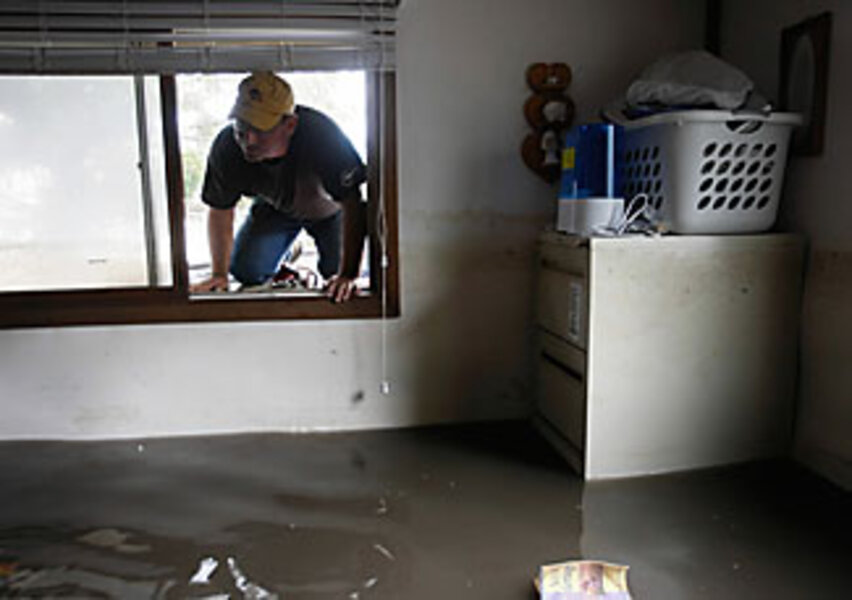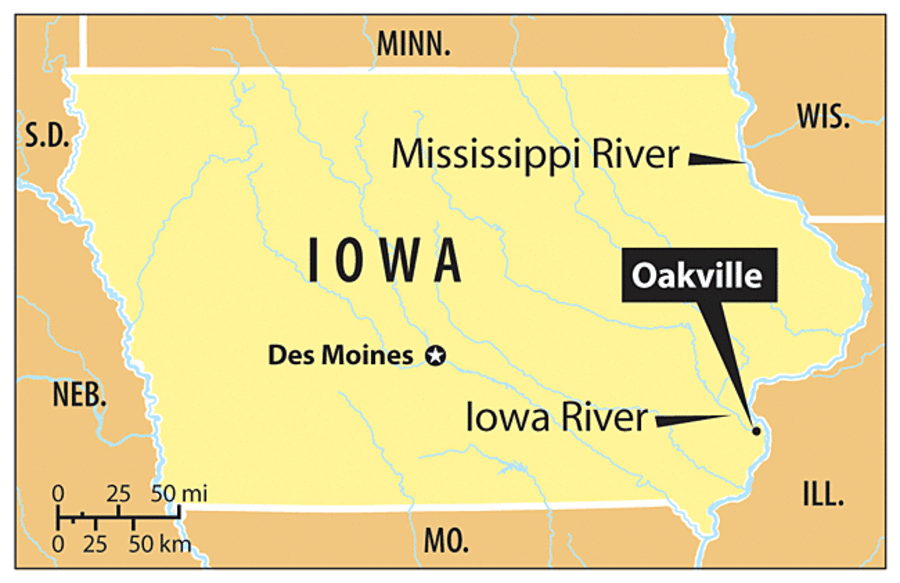Midwest floods may leave small towns smaller
Loading...
| Wapello, Iowa
Wayne Gerst's farm has been in his family for 62 years; now it's under eight feet of water.
The farm, in tiny Oakville, Iowa, is one of many places submerged in a town that's still under water 1-1/2 weeks after its levee was overtopped.
"The water's going down slowly," says Mr. Gerst's wife, Joleen, after doing a flyover of the region Tuesday. She shows photos taken last week by boat: Water is up to the garage roof, and roses – "my best year ever for flowers" – peek out of the very top of the otherwise submerged arbor.
The Gersts plan to return when the water recedes. Many of their neighbors don't. What the future holds for the town of about 400 on the edge of the Iowa River is anyone's guess.
As swollen rivers burst over levees in the upper Midwest this month, many of the areas hardest hit are farm towns like Oakville. These hamlets now face particular challenges: the likelihood that some residents won't move back to already-dwindling towns, farm-dependent economies that may be hurt by crop loss, and a lack of resources or experienced town officials to navigate the red tape of state and federal assistance programs.
Some towns, flooded for the fourth or fifth time, may weigh whether to rebuild at all.
"Whatever magnet these communities had for retaining population gets weakened every time you have something like this," says David Swenson, an economist at Iowa State University, noting that many people in small towns no longer work there but stay because of family ties or history or cost of living. "Bring in a catastrophe like this, and that severs those ties and those rationales."
That's the case for many Oakville residents, who discuss future plans as they gather at Solid Rock Baptist Church in nearby Wapello for meals, showers, camaraderie, and information. Only a handful of them had flood insurance: Because their town avoided the big floods of 1993, and they were protected by a so-called 100-year levee, they felt safe.
"I was in floods when I was young. This was the fourth time and it's the last time," says Nancy Wehage, over lunch with her former neighbors at the church. She doubts she'll move back. "We're getting too old to do this stuff."
Oakville Mayor Benita Grooms, who also served as mayor back in '93, says it's too soon to know what the future holds for the town. Disaster teams are just now gaining access to the still-flooded town, so she doesn't yet know the full extent of the damage or what the plans are for rebuilding the town's levee.
"If FEMA does buyouts, that's dead property," she says, noting that the town's tax base is already scant. "I don't know if we'll survive as a full-blown community."
Some experts say towns like Oakville – or those like Gulfport, Ill., or Alexandria, Mo., that have flooded repeatedly in the past 50 years – should consider whether rebuilding is wise.
A few devastated towns did in fact move. After Valmeyer, Ill., flooded in '93, the town relocated a mile and a half to the east, and 400 feet higher.
"More towns should consider it, but it's not an easy process," says Dennis Knobloch, Valmeyer's mayor at the time, recalling that he dealt with more than 35 state and federal agencies. It would be better for certain towns – those that flood repeatedly, for instance – to think about relocating in nonflood years, when they're not reeling from a disaster, he says.
But Valmeyer's move is a rare and not always viable one, and human nature is geared to forget disasters and to feel safe, say experts.
"Throughout all of human history, human beings have been unrelenting in rebuilding in areas that have been devastated by disasters," says Dennis Mileti, a retired sociology professor at the University of Colorado and author of "Disasters by Design." State and federal policy, he says, can try to change that tendency, but it's hard to do because most land-use and building decisions are made at the local level.
"Left to their own volition, people really don't perceive risk," he says. The answer isn't always to abandon areas such as floodplains, he adds, but rather to build "consistent with the risk." Still, "small communities don't have the technical expertise or resources to be able to raise those questions or come up with good answers to them," he says.
At this point, Oakville residents are too busy meeting immediate needs – finding a place to live, bringing some semblance of order to their lives, and hoping to regain access to their homes to assess the damage – to contemplate the town's future. But many say they aren't likely to move back to a place where they could go through this again.
"I'm not going to build a new house in a floodplain like that, at our age," says Bob Siegle, a farmer who was born in Oakville and lived with his wife, LeeAnn, in his grandparents' house. Like the Gersts, Mr. Seigle says he'll continue to farm his land, but he plans to live somewhere else.
He guesses that Oakville will continue to exist in a fashion, but notes that the eroding tax base will be a blow to a town whose businesses had already dwindled to a feed mill, a grain elevator, a bank, a post office, and a few small stores.
"It'll be a different normal," he says. "This is an awful big blow to a small country town."



